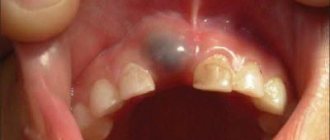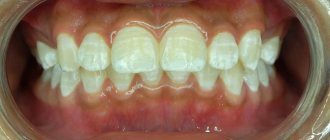White spots on a child’s teeth: a simple defect or an alarming symptom
All parents want to see their child happy and healthy. Therefore, it is important to carefully monitor the condition of his body. For any alarming symptoms, a causative factor must be found. Attentive attention to oral health is one of the main conditions for ensuring good health for the baby. If you notice white spots on your child's teeth, there is no need to panic, but you should not let the problem take its course. More often it indicates the beginning of the development of caries, but it can also manifest itself for other reasons. The dentist will help you cope with the problem.
What does ignoring the problem lead to?
Failure to promptly contact a dentist when plaque appears on baby teeth leads to the following negative consequences:
- development of the inflammatory process;
- bleeding gums, which occurs if the child eats or brushes his teeth;
- the likelihood of developing diseases such as caries, stomatitis and periodontal disease increases;
- milk teeth with a black coating are very unaesthetic, which is fraught with the development of complexes in the child;
- deposits may be accompanied by bad breath.
White spots on enamel: what are they?
More often, white spots appear on baby teeth, less often on permanent teeth. Experts divide them into two classes:
- carious - those that are associated with the development of caries;
- non-carious.
White areas on the enamel indicate its demineralization. A whitish line may also appear at the edge of the gums of the front teeth. In any case, consultation with a doctor is required.
Compared to permanent teeth, baby teeth are more susceptible to caries. Their enamel is thin and porous, which allows bacteria to easily penetrate inside. The disease progresses quickly, so in a short period of time there may be nothing left of the tooth. There is a risk of damage to the “successor” rudiments. These facts refute the opinion of some parents that there is no need to treat baby teeth, since they must be replaced.
What is Priestley's plaque
Plaque on baby teeth of a yellowish, black or brown color appears in a child when bacteria actively multiply in the oral cavity. Priestley's plaque is often seen at an early age, but can also occur in older children. When deposits appear, teeth lose their attractiveness, which can negatively affect the child’s psychological state. If symptoms of this unpleasant phenomenon develop, you should immediately contact your dentist to eliminate Priestley’s plaque in children.
Carious lesions
Caries is the most common dental disease. It is usually caused by poor oral hygiene. A white spot on the enamel is the initial stage of the carious process, which is easy to treat and does not require the use of equipment that is so scary for a child, such as a drill. If you palpate the problem area, you may feel roughness. By postponing a visit to the dentist, the enamel in the affected area becomes thinner, softens and begins to deteriorate.
Plaque and tartar
Essentially, these are 2 stages of one process. You can figure out whether there are hard deposits on your teeth by looking at the plate below:
| Signs | Raid | Tartar |
| Color | Any: from white to black. Comes with a greenish tint | Color from dark yellow to dark brown |
| Location | On any surface | More often, where it is difficult to clean your teeth well: on the inside of the front teeth, in the spaces between teeth, close to the gums. More often seen with crowded teeth |
| What cleaning methods does it lend itself to? | Clean with a brush with paste or homemade bleaching products, such as lemon | Can't remove it at home |
If you see plaque on your baby that cannot be removed with a brush, it’s time to visit a doctor.
Excess or lack of fluoride
Fluoride is an element important for teeth, which largely enters the human body with water. It is also found in toothpastes, some foods and polluted air. Excessive intake of fluoride provokes the development of a disease called fluorosis, one of the symptoms of which is white or yellow spots on the enamel. They are often subtle and are identified when visiting a doctor. The coloring of defects may be uneven.
Baby teeth are more susceptible to disease. The appearance of permanent ones reduces the risk of developing fluorosis. Children with chronic diseases and weakened immunity are also at risk.
Fluoride deficiency is also harmful to teeth. In this case, they become vulnerable, which causes tooth decay and gum disease.
Black plaque in children
If your child’s teeth have turned black, you should definitely visit the dentist. But they don’t necessarily have to be treated as a result. Perhaps this is Priestley's plaque - it can be caused by harmless bacteria that do not cause caries, but produce pigment. This plaque does not look very aesthetically pleasing, but it does not necessarily need to be removed - after all, it does not cause harm and does not cause diseases of the teeth and gums. Only a dentist can distinguish Priestley plaque from caries and make recommendations for treatment or aesthetic procedures.
Enamel hypoplasia
We are talking about severe thinning, partial or complete absence of enamel. Hypoplasia is a disease that manifests itself not only in the form of whitish spots, but also grooves and depressions on the tooth surface. It can be triggered by various factors:
- infectious diseases during pregnancy;
- Rh conflict between mother and fetus;
- premature birth;
- birth injury;
- taking certain illicit drugs by a pregnant woman;
- disturbances in the functioning of the endocrine, nervous systems or gastrointestinal tract.
The pathology is accompanied by increased sensitivity of teeth to irritants and caries.
Causes of black plaque in children
The main causes of black plaque on teeth are:
- Priestley plaque is the main cause of deposits. Growing up, the child gets rid of this problem, since plaque almost never settles on permanent teeth. This phenomenon does not harm health and is characterized as a purely aesthetic defect.
- Tooth decay is a serious disease that can lead to tooth loss. The carious process is accompanied by yellowing and subsequently blackening of the tooth enamel. When the first symptoms appear, you should immediately consult a dentist.
- Dysbacteriosis is a disease that leads to the appearance of dental plaque due to disturbances in the functioning of the digestive system. The causes of the disease are poor diet, long-term use of medications, chronic diseases affecting the liver or intestines.
- Oversaturation of the body with iron. Prescribing iron-containing medications to children leads to the formation of both black plaque and deposits that are dark purple or brown in color.
In addition, teeth can darken due to a lack of calcium in the body caused by some disease. In general, the exact cause will be revealed during an examination by a dentist.
How can a specialist help?
To determine the cause of the problem, you need to contact your dentist. He will conduct a visual examination, assess the size of the spots, the degree of enamel destruction, and the number of teeth involved in the painful process. In the initial stages of caries, remineralization and fluoridation help. If the disease has affected the deeper structures of the tooth, you cannot do without using a drill and filling.
If whitish spots occur while wearing braces or other orthodontic construction, a comprehensive approach is taken to solving the problem:
- treat caries;
- carry out disinfection;
- replace corrective devices with new ones;
- carry out professional cleaning to remove plaque.
In some cases, the help of highly specialized specialists may be needed (if the doctor rules out dental pathologies).
Diagnosis and treatment methods of Priestley plaque
The appearance of black plaque can be the result of various diseases. In order to prevent them from starting and to prevent the development of complications, it is necessary to carry out a number of diagnostic measures. Even if a small spot appears on a tooth, you should visit a doctor and undergo laser diagnostics.
If it is caries, then at an early stage of development it is much easier to cure. In addition, the doctor may prescribe additional tests: blood and urine tests. Depending on the results obtained, appropriate treatment methods are selected:
- If problems with the gastrointestinal tract are identified, it is necessary to review the child’s nutritional system. In this case, a special diet is prescribed and some foods are excluded from the diet.
- Lack of calcium or excess iron can be easily treated by taking corrective medications and eating certain foods in greater or lesser quantities.
- When identifying caries at an early stage, dental procedures such as silver plating or fluoridation can help. The doctor treats the teeth with a special solution, which helps prevent further development of the disease and wait for healthy permanent teeth.
- Common Priestley plaque can be removed by professional cleaning by a doctor. But, unfortunately, this is not a guarantee that it will not appear again after a while.
If stains or plaque on the teeth cause pain or discomfort to the child, fillings are used to preserve the teeth and eliminate discomfort.
Eliminating white spots on teeth: what you can do at home
If the problem lies in an excess or deficiency of fluoride, you may need to change the water or install a filter that will remove this element. For fluorosis, toothpastes purchased for a child should not contain fluoride.
If a child is one year old and already has white spots on his teeth, his diet needs to be adjusted. It is important that in addition to breast milk, the diet contains foods containing calcium and vitamins, such as cottage cheese and vegetables. If the baby is on artificial nutrition, you should make sure that he does not fall asleep with a bottle in his mouth. Remains of sweet milk formula can trigger the development of so-called bottle caries.
It is also necessary to pay great attention to oral hygiene. Parents should take care of their teeth first. And when the baby becomes more independent, you need to teach him the basic rules of hygiene. Your doctor will also give you recommendations for care.
Brown plaque in infants
Your baby has not yet switched to foods from the adult table, but has he already developed a brown coating? Causes:
- sweet additives in the diet;
- night feedings;
- illnesses the mother suffered during pregnancy.
Caries can develop even before the baby's first year has passed if you offer him a lot of sweet drinks and purees.
Night feedings are another reason. At night, saliva is produced in smaller quantities, so if a child drinks milk, the teeth are not so intensively washed with salivary fluid and are not cleaned. Bacteria settle on them, causing gradual darkening and hardening of the deposits. The result is caries.
If a woman suffered severe toxicosis or was ill while carrying a child, her body felt a lack of essential vitamins and microelements. Therefore, the laying of the baby’s first teeth occurred “with errors”: the milk teeth, growing, quickly became affected by caries.
Preventive measures
It is important to provide your child with proper dental care. Immediately after the first incisor appears on an infant, it is necessary to thoroughly clean it with a special brush-finger 2 times a day. It is necessary to ensure proper oral care even before teething begins. For this purpose, wipe the gums with a sterile piece of gauze soaked in boiled water. Other preventative measures:
- limiting the consumption of sweets, confectionery, carbohydrate foods, acidic foods and drinks;
- regularly visit the dentist with your child - at least 2 times a year, ideally - every 3-4 months;
- Give your baby vitamin complexes after illnesses and during periods of active growth - only as prescribed by the pediatrician.
It is important for the expectant mother to follow a diet and not take medications without the doctor’s approval.
How to remove black plaque on teeth
It is impossible to remove dental plaque at home. Moreover, the use of abrasive agents and intense exposure to teeth with a brush can cause an increase in dental problems: thinning or damage to the enamel, trauma to the gums or mucous membrane.
Priestley's plaque on children's teeth can only be removed in a well-equipped dental clinic. The specialist will:
- professional teeth cleaning;
- If necessary, treat the teeth with a remineralizing composition.
If plaque formation is caused by dental problems, additional treatment may be prescribed, including bite correction.
The doctor will also select a home hygiene kit that is ideal for the child: a toothbrush of the correct shape and hardness, toothpaste with the optimal composition, and mouth rinse. Additionally, the hygienist will teach the child how to brush their teeth correctly and will talk about the need for quality oral care.
Taking into account the causes of the disease, the dentist may prescribe additional treatment measures, for example, recommend dietary supplements, dietary nutrition, avoidance of drinks and foods with dyes that affect the color of the enamel.
Advice from Dr. Zubastik
Have you discovered that your baby’s teeth are covered with plaque? Try cleaning them first or watch your child do this procedure. If deposits remain, make an appointment with your dentist. He will take action: he will explain what to add to your diet when caring for your teeth so that the enamel does not change shade, and, if necessary, he will perform silver plating or put a filling.
For certain indications, a child over 10 years old is allowed to have their teeth brushed. This procedure may be necessary in your case.
Keep an eye on your child’s teeth – this is an indicator of the general state of the immune system. Are they white and strong? Congratulations, your young heir can boast of excellent health!
When to start brushing your child's teeth
Caring for the oral cavity of a newborn means periodic examination. But as soon as the first tooth appears, brush it. The baby's first brush is a special fingertip for the mother, one side of which is covered with soft short bristles. Put it on and massage your teeth. This should not cause any discomfort to the baby.
Dr. Komarovsky advises starting full-fledged care from the age of one and a half years. He names the main reasons for the transformation of enamel shade in children:
- metabolic disease;
- lack of calcium and vitamin D;
- indoor air is too dry;
- insufficient functions of saliva.
A dental examination of baby teeth is mandatory. The doctor will find the root of the problem and tell you how to eliminate the cause of the formation.









